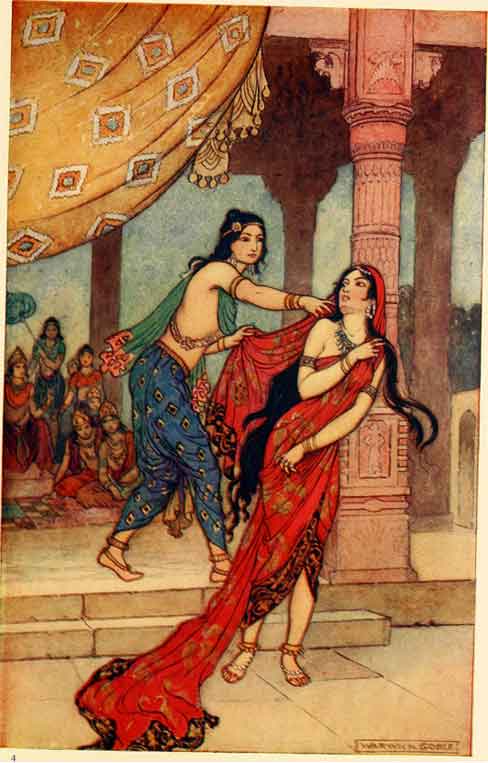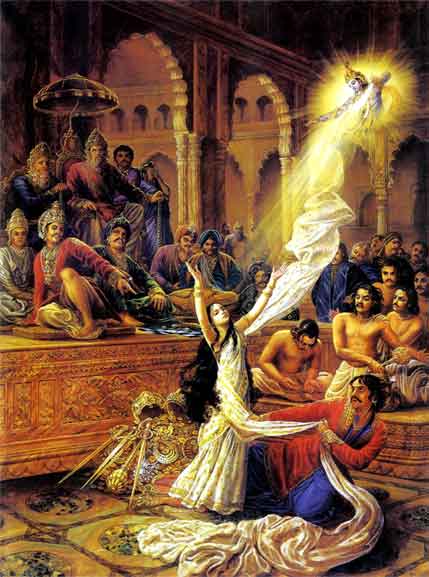Like most children in India, I grew up with enchanting stories full of gods, demons and kings. I still reminisce about those hot summer afternoons when my grandmother would deftly slice juicy mangoes and tell us stories from the great Indian mythological epics: Ramayana and Mahabharata.
As a kid, I always preferred Ramayana, for the simple reason that it was easier to understand. A demon, an abduction, a war and then happily ever after. The Mahabharata, on the other hand, is an intricate web of complex characters and collateral events. The basic story of the Mahabharata involves two main groups of princes-the Pandavas and the Kauravas– and their ultimate battle for the coveted throne of Hastinapur. However, the story isn’t as simple as it seems.
Who is Draupadi?
The Mahabharata is longer than any poem ever written and has more characters than any modern work of fiction. These intertwined characters and the bizarre consequences of their actions make the story convoluted and interesting.
One such character is Draupadi. Touted as the most beautiful woman of her time, Draupadi is most notoriously known for being married to five brothers at the same time and for her shocking “vastraharan” (forced public disrobement). Mysteriously, in spite of her crucial role in the story, Draupadi is always present at the periphery of the story, never quite portrayed as the protagonist.
The Palace of Illusions: Draupadi’s Mahabharata
‘The Palace of Illusions’ is unique among other Mahabharata novels because its narrator is a woman: Draupadi.
Perhaps, Draupadi is one of the most misunderstood and belittled characters in the epic, but one of the strongest too. This is a novel concept in a then highly patriarchal society.
Yes, we’re talking about a time when marriage and family were the only ambitions that a woman was allowed to nurture, but that does not make the Mahabharata devoid of strong women. It is through the perspective of one such headstrong woman that Divakaruni [the author] chooses to tell this riveting tale.
A dreadful victim or a proud hero?
The name ‘Draupadi’ conjures both positive and negative connotations. Perhaps that is the reason why there’s hardly any women named Draupadi in India today, compared to the multitude of Sitas. Draupadi’s supposed blasphemy of marrying five brothers at the same time and the fact that she was victimised and publicly disrobed paints a very sorry and misleading picture about the woman who was, in fact, prophesied to ‘change the course of history’.
In her book, Divakaruni transforms this grossly misunderstood notion and introduces the real Panchaali:
A headstrong princess with radical ideas; a woman who makes more sacrifices than any of her male counterparts; a queen whose glory is overshadowed by the glory of her husbands.
In a language enriched with beautiful metaphors, a style that is so typical of her writing, Divakaruni emphatically captures the essence of the fierce yet vulnerable character of Draupadi.
The Plot: Becoming the Queen of the Palace of Illusions
In her distinctive, feminine style of writing, Divakaruni narrates the story of how a passionate woman’s wrath hurls an entire kingdom into a bloody war.
The novel begins with the innocent musings of a lonely princess, Panchaali [as the author referred to Draupadi] who wishes to break the confines of her father’s palace. In a superior narrative fashion, Divakaruni introduces the central characters of the great epic through their interactions and relationships with Paanchali. Frustrated at being cooped up in her father’s palace, Paanchali often wonders if she has what it takes to change the course of history.
Divakaruni’s novel takes us on a journey as naïve Panchaali gradually becomes cognizant of herself and the world around her. Trapped between her unusual marriage and a dilemma over her feelings for a certain man who isn’t good for her, Panchaali enters the tumultuous world outside her father’s palace. Diligently circumventing minor political setbacks and a manipulative mother-in-law, Divakaruni’s character paves way towards the most glorious period of her life as she becomes the queen of the Palace of Illusions, a delusory and alluring abode where nothing is as it seems. As the years pass, Draupadi becomes immensely attached to her serene palace and regards it as a reflection of her true, inner self.
However, in an ironical twist of events, it is ultimately this palace, which Panchaali so dearly loves, that pushes her into a downward spiral. The terrible events that follow unveil the darker side of Panchaali’s character. The dichotomy between Panchaali’s benevolent and malevolent nature is the crux of the Divakaruni’s Mahabharata. In her distinctive, feminine style of writing, Divakaruni narrates the story of how a passionate woman’s wrath hurls an entire kingdom into a bloody war.
The Pandavas Through Panchaali’s Eyes
The Pandavas, the protagonists; Karna, the tragic hero and Krishna, Panchaali’s charming and evasive best friend are some of the other main characters that the author portrays through Panchaali’s emotions. Divkaruni’s delineation of Panchaali’s relationship with Krishna, a bond that hovers between friendship and devotion, gives the novel a philosophical charm.
Divakaruni confesses that a part of her story is fictional- such as Paanchali’s innermost feelings and romantic desires that equate her to almost any other ordinary woman but there is something about the author’s immersive narration that dissolves any boundaries between fact and fiction thus making the story beautifully engaging.












